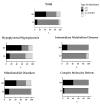Utility of Gene Panels for the Diagnosis of Inborn Errors of Metabolism in a Metabolic Reference Center
- PMID: 34440436
- PMCID: PMC8391361
- DOI: 10.3390/genes12081262
Utility of Gene Panels for the Diagnosis of Inborn Errors of Metabolism in a Metabolic Reference Center
Abstract
Next-generation sequencing (NGS) technologies have been proposed as a first-line test for the diagnosis of inborn errors of metabolism (IEM), a group of genetically heterogeneous disorders with overlapping or nonspecific phenotypes. Over a 3-year period, we prospectively analyzed 311 pediatric patients with a suspected IEM using four targeted gene panels. The rate of positive diagnosis was 61.86% for intermediary metabolism defects, 32.84% for complex molecular defects, 19% for hypoglycemic/hyperglycemic events, and 17% for mitochondrial diseases, and a conclusive molecular diagnosis was established in 2-4 weeks. Forty-one patients for whom negative results were obtained with the mitochondrial diseases panel underwent subsequent analyses using the NeuroSeq panel, which groups all genes from the individual panels together with genes associated with neurological disorders (1870 genes in total). This achieved a diagnostic rate of 32%. We next evaluated the utility of a tool, Phenomizer, for differential diagnosis, and established a correlation between phenotype and molecular findings in 39.3% of patients. Finally, we evaluated the mutational architecture of the genes analyzed by determining z-scores, loss-of-function observed/expected upper bound fraction (LOEUF), and haploinsufficiency (HI) scores. In summary, targeted gene panels for specific groups of IEMs enabled rapid and effective diagnosis, which is critical for the therapeutic management of IEM patients.
Keywords: differential diagnosis; genetic diagnosis; inborn errors of metabolism.
Conflict of interest statement
The authors declare no conflict of interest.
Figures




References
Publication types
MeSH terms
LinkOut - more resources
Full Text Sources
Medical

